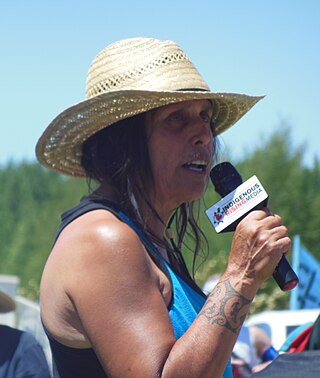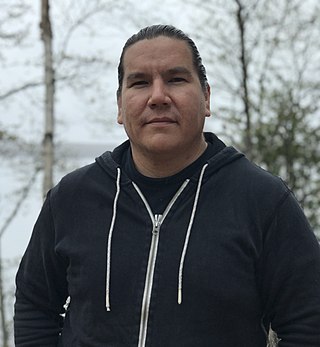
Winona LaDuke is an American environmentalist, writer, and industrial hemp grower, known for her work on tribal land claims and preservation, as well as sustainable development.

The Saulteaux, otherwise known as the Plains Ojibwe, are a First Nations band government in Ontario, Manitoba, Saskatchewan, Alberta and British Columbia, Canada. They are a branch of the Ojibwe who pushed west. They formed a mixed culture of woodlands and plains Indigenous customs and traditions.

A mooncake is a Chinese bakery product traditionally eaten during the Mid-Autumn Festival (中秋節). The festival is primarily about the harvest while a legend connects it to moon watching, and mooncakes are regarded as a delicacy. Mooncakes are offered between friends or on family gatherings while celebrating the festival. The Mid-Autumn Festival is widely regarded as one of the four most important Chinese festivals.

The Anishinaabe are a group of culturally related Indigenous peoples in the Great Lakes region of Canada and the United States. They include the Ojibwe, Odawa, Potawatomi, Mississaugas, Nipissing, and Algonquin peoples. The Anishinaabe speak Anishinaabemowin, or Anishinaabe languages that belong to the Algonquian language family.

CBCS-FM is a Canadian radio station. It is the CBC Radio One station in Sudbury, Ontario, broadcasting at 99.9 FM, and serves all of Northeastern Ontario through its network of relay transmitters. The station's studio is located at the CBC/Radio-Canada facilities at 43 Elm Street in Sudbury.

The Lac Courte Oreilles Tribe is one of six federally recognized bands of Ojibwe people located in present-day Wisconsin. It had 7,275 enrolled members as of 2010. The band is based at the Lac Courte Oreilles Indian Reservation in northwestern Wisconsin, which surrounds Lac Courte Oreilles. The main reservation's land is in west-central Sawyer County, but two small plots of off-reservation trust land are located in Rusk, Burnett, and Washburn counties. The reservation was established in 1854 by the second Treaty of La Pointe.

Shingwauk Kinoomaage Gamig is a Canadian Indigenous-led institute, with Algoma University in Sault Ste. Marie as one of its main partners. Shingwauk Kinoomaage Gamig is one of nine Indigenous institutes in Ontario's post-secondary system and collaborates with other colleges and universities to offer post-secondary programs geared specifically toward Indigenous students.

Robin Cass is a Canadian film and television producer. He is most noted as the producer of John Greyson's film Lilies, which won the Genie Award for Best Picture at the 17th Genie Awards in 1996. He has also been a supervising producer for the CBC TV series Kim's Convenience.
Margaret A. Noodin (née O’Donnell) is an American poet and Anishinaabemowin language teacher. She is a professor of English and American Indian studies at the University of Wisconsin–Milwaukee and Associate Dean of the Humanities. She also directs a tribal Head Start program in Minnesota.

The Caldwell First Nation is a First Nations band government whose land base is located in Leamington, Ontario, Canada. They are an Anishinaabe group, part of the Three Fires Confederacy, comprising the bands Potawatomi, Odawa, and Ojibwa, whose members are originally of the Mikinaak (Turtle) and the Makwa (Bear) dodems. The Caldwell First Nation are a distinct and federally recognized Indian band and used to be referred to by such names as the "Chippewas of Pelee", "Point Pelee Indians" and "Caldwell's band of Indians."
Leanne Betasamosake Simpson is a Mississauga Nishnaabeg writer, musician, and academic from Canada. She is also known for her work with Idle No More protests. Simpson is a faculty member at the Dechinta Centre for Research and Learning. She lives in Peterborough.

Elizabeth LaPensée is a game designer and games researcher. She is currently the Narrative Director at Twin Suns Corp, a Seattle-based AAA studio. She has previously worked as an associate professor in the Department of Writing, Rhetoric, and American Cultures at Michigan State University. She studies and creates video games, interactive digital media, animation, visual art, and comics to express Indigenous ways of knowing.
Josephine Mandamin was an Anishinaabe grandmother, elder and founding member of the water protectors movement.

Cherie Dimaline is writer and a member of the Georgian Bay Métis Council of the Métis Nation of Ontario. She is most notable for her 2017 young adult novel The Marrow Thieves, which explores the continued colonial exploitation of Indigenous peoples.
Joanne Robertson Misko Anungo Kwe (Red Star Woman) is an Anishinaabe author, illustrator, and water protection activist. Joanne is a member of Atikameksheng Anishnawbek and is of the Bald Eagle clan.

Waubgeshig Isaac Rice is an Anishinaabe writer and journalist from the Wasauksing First Nation near Parry Sound, Ontario. Rice has been recognized for his work throughout Canada, including an appearance at Wordfest's 2018 Indigenous Voices Showcase in Calgary.

Sheila North is a Cree leader and journalist, who formerly served as Grand Chief of Manitoba Keewatinowi Okimakanak.
Paul Rabliauskas is a Canadian stand-up comedian, most noted as the star of the 2022 sitcom Acting Good.
Naawi-Oodena is an urban reserve in Manitoba. Jointly controlled by the Brokenhead, Long Plain, Peguis, Roseau River, Sagkeeng, Sandy Bay and Swan Lake First Nations, the 160-acre parcel is located near the River Heights and Tuxedo neighbourhoods of southwest Winnipeg, and is the largest urban reserve in Canada.












